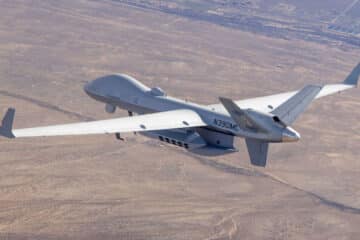The MQ-9B STOL can operate from amphibious assault ships without the need for a ski jump or catapult. The new design features folding wings optimised for short takeoff and landing (STOL), as well as an enlarged v-tail.
Talking to Naval News at the show, General Atomics explained that the design is capable of operating from the U.S Navy’s America-class Landing Helicopter Assaults (LHA) and Wasp-class Landing Helicopter Dock (LHD) ships. They can also operate aboard the Royal Australian Navy’s Canberra-class LHDs.

General Atomics is pitching the MQ-9B STOL to the United States Marine Corps (USMC) as an expeditionary, shipborne alternative to the service’s new MQ-9As. The USMC currently plans to procure 16 MQ-9As through the Marine Air Ground Task Force (MAGTF) Unmanned Systems Expeditionary (MUX) program of record.
In addition to the United States, the United Kingdom and Australia have reportedly expressed interest in the design for operations from their Queen Elizabeth-class and Canberra-class vessels respectively. General Atomics is also in talks with unspecified “Pacific” countries. Naval News understands these countries are likely Japan (with the Izumo-class and Hyūga-class “helicopter destroyers”) as well as South Korea (with the upcoming CVX carrier).



While the MQ-9B STOL sacrifices some range so that it can fly from flat top amphibious warships, it still has a significant endurance of roughly 30 hours, far more than smaller ship-launched unmanned aerial systems.
Like the MQ-9B Sea Guardian, the MQ-9B STOL can carry and dispense sonobuoys, allowing it to provide long range, high endurance, anti-submarine warfare capabilities to any naval task force. Promotional videos released by GA-ASI also depict the MQ-9B STOL carrying AGM-114 Hellfire and AIM-9 Sidewinder missiles.






